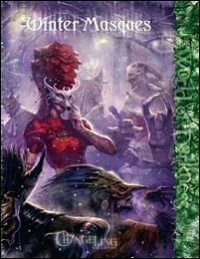Knighthood of the Dragonslayer
From Edge of Darkness Wiki
m |
m |
||
| Line 7: | Line 7: | ||
|Pages=pp. 149-151 | |Pages=pp. 149-151 | ||
}} | }} | ||
| - | + | Saint George’s legacy lives on in the form of a noble order. The Knighthood of the Dragonslayer — or Ordem dos Cavaleiros Matadors de Dragão — still works today, but not necessarily in a militaristic capacity. While members are expected to have some martial prowess to their credit, what they really do is function as spies, interrogators and policemen. It is their job to kick over the rotting log from time to time to see what wretchedness crawls underneath. If what’s exposed cannot be abided, they do whatever must be done to either continue the disclosure or to end it where it lays. If this means torture, then it means torture. If it means threats against the innocent, then one must abide not by the individual but by the needs of the greater good. The Knighthood is very utilitarian in this way, and will do what it must to keep its freehold safe from treachery. | |
| Line 16: | Line 16: | ||
===The Grand Cross of Saint George (Privilege)=== | ===The Grand Cross of Saint George (Privilege)=== | ||
Many knights of the order wear this cross — cobbled together from gems, seeds, bits of glass and other debris found in the Hedge — as part of a sash badge worn across the chest, though many simply pin it to a shirt or jacket. When activated and pressed against the skin of another, the cross is said to sense the sin within that person’s heart. The cross burns the skin provided that the target’s [[Morality]] score (or its equivalent, be it [[Clarity]], [[Harmony]], [[Humanity]] or [[Wisdom]]) is at 5 or below. For every one below 5, the cross does an additional point of lethal damage (Morality 5 causes one lethal, Morality 4 causes two lethal and so forth to a maximum of five lethal damage). In addition, one can heal the injury, but the cross leaves a permanent plus-shaped scar upon the flesh. If pressed against the flesh of someone with Morality 6 or higher, the cross has no effect (other than to tell the wielder that the victim may not be quite the sinner one suspected). | Many knights of the order wear this cross — cobbled together from gems, seeds, bits of glass and other debris found in the Hedge — as part of a sash badge worn across the chest, though many simply pin it to a shirt or jacket. When activated and pressed against the skin of another, the cross is said to sense the sin within that person’s heart. The cross burns the skin provided that the target’s [[Morality]] score (or its equivalent, be it [[Clarity]], [[Harmony]], [[Humanity]] or [[Wisdom]]) is at 5 or below. For every one below 5, the cross does an additional point of lethal damage (Morality 5 causes one lethal, Morality 4 causes two lethal and so forth to a maximum of five lethal damage). In addition, one can heal the injury, but the cross leaves a permanent plus-shaped scar upon the flesh. If pressed against the flesh of someone with Morality 6 or higher, the cross has no effect (other than to tell the wielder that the victim may not be quite the sinner one suspected). | ||
| + | |||
'''Action''': [[Action::Instant]] | '''Action''': [[Action::Instant]] | ||
| Line 27: | Line 28: | ||
===Joining=== | ===Joining=== | ||
| + | The Knighthood welcomes new changelings with open arms. Certainly it tests them. The Dragonslayers examine every piece of a neophyte’s life, sifting through the remains of his mortal life, taking a close look at the fetch, drawing out the terrible dreams of one’s durance to ensure that the changeling doesn’t still secretly harbor hidden puppet strings that connect him to his Keeper. | ||
| + | |||
| + | One interesting factor regarding new members it that, if the knights are able to extract a confession of treason from a changeling, they might offer that traitor a second life within the group. Traitors aren’t given a free pass, of course, and unlike other knights, traitors are scrutinized for many years to ensure that their duplicitous ways are burned out of them, but it allows them to forestall their executions. And, many such “second-chance” changelings end up being the Knighthood’s most zealous members. | ||
| + | |||
{{Links|Entitlements}}{{footer|ctl}}[[Category:Changeling: The Lost]] | {{Links|Entitlements}}{{footer|ctl}}[[Category:Changeling: The Lost]] | ||
Revision as of 04:25, 18 April 2016
| |||||||||||||||||||
